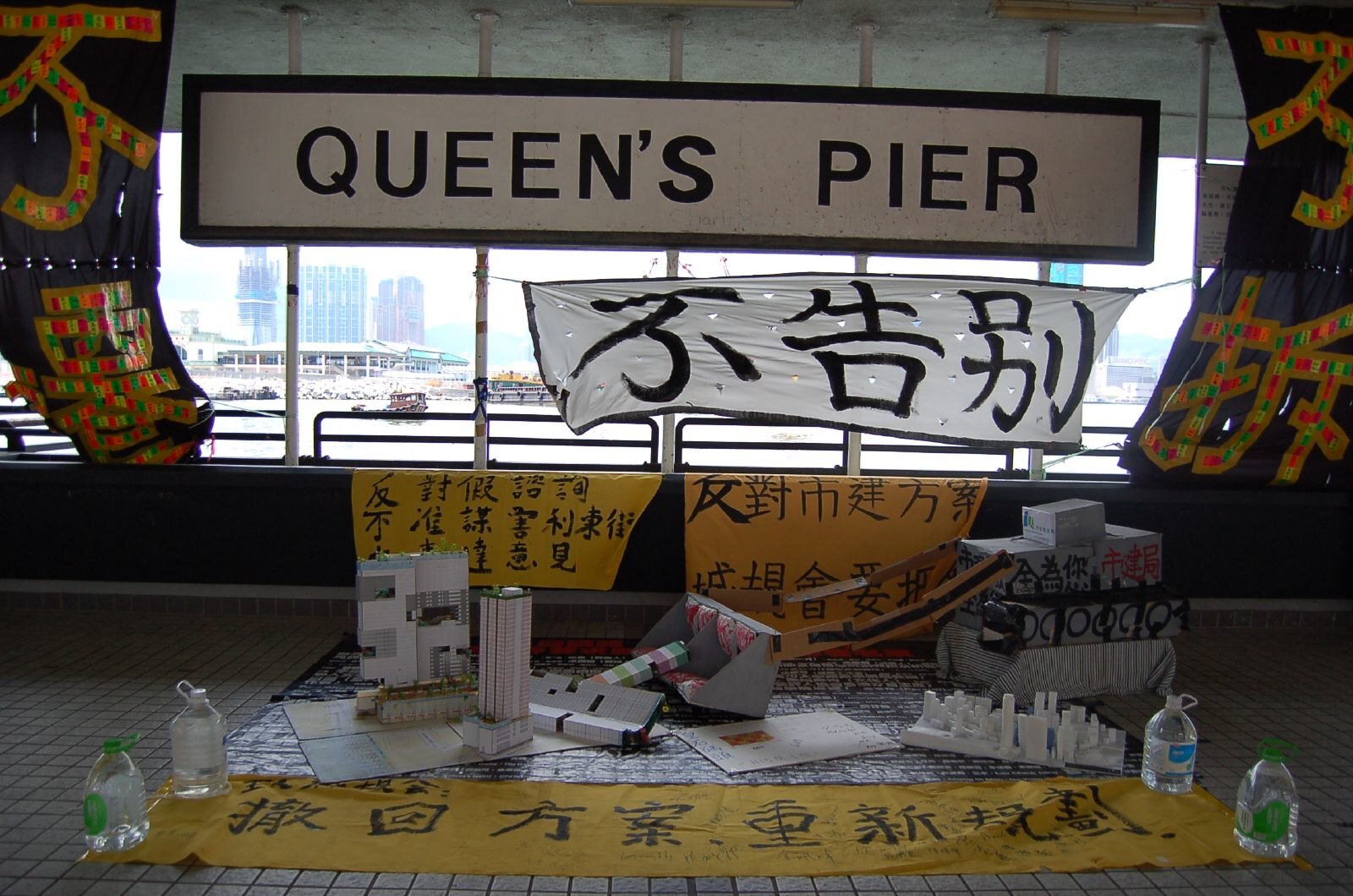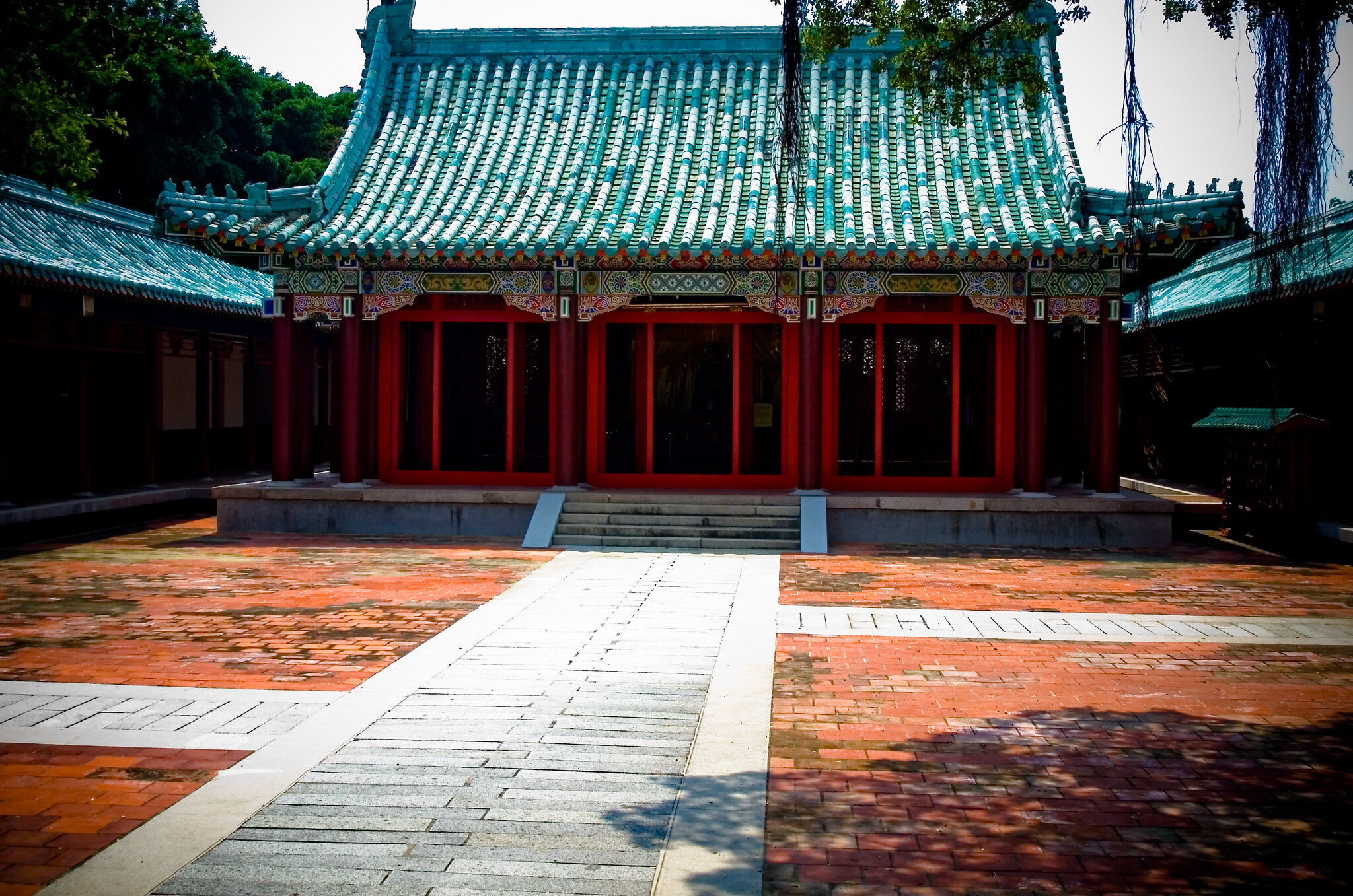Taiwan Jingu
Emergence of Contestation: 1901
Taiwan's general protector shrine, Taiwan Jinja, was established six years after Taiwan came under Japanese control. The three Pioneer Kami were enshrined in the first seat of the shrine, while a second seat enshrined Prince Kitashirakawa-no-miya Yoshihisa, who had died in Tainan in 1895 of malaria, after leading a successful pacification campaign against the remaining Qing loyalists in Taiwan. Like others in Taiwan, the shrine itself was handed over to the Republic of China after 1945, but remained largely unaltered until the 1970s. Then, as part of a broader policy of removing the traces of Japanese colonization and fostering patriotism, the shrine was razed and replaced with the towering Taipei Grand Hotel in 1973, which showcased northern Chinese (as opposed to southern Chinese or Taiwanese) architecture.
Desecration or Veneration: The Legacy of Shinto Shrines at the Borders of Imperial Japan - Karli Shimizu
Queen's Pier
Emergence of Contestation: 2007
The Queen's Pier in Hong Kong can function as a case study of the degree to which (formerly) colonial spaces continue to shape people's relationships to their colonial past and their own identitities even in the post-colonial period, through their spatial design intertwined with colonial education which generate lasting control systems impacting both body and mind.
Tracing the inveterate (post-)colonial controls: Queen's Pier in Hong Kong and the 'Cape No. 7' in Hengchun, Taiwan - Liza Wing Man Kam
Qijin Kitchen, Kaohsiung
Qijin kitchen is a project developed by the Taiwanese artist Wu Mali in Kaohsiung, the main harbour city in the south of Taiwan. The kitchen is located on Qijin island, a thin band of land that separates the inner bay of Kaohsiung from the ocean. The history of Kaohsiung harbour is tied to the island’s position at the top of the Southern China seas. Qijin island has been for many centuries populated by fishermen, and today is made to stand for a ‘vernacular Taiwan’, a glimpse into the pre-industrialized world. This is a false impression, as the population, in the past as today, is made up of migrants sailing the waves of history, and consuming foodstuffs from well beyond Taiwan's current borders.
Art in Former Military Sites: Spectres of Geopolitics in Southeast Asia - Gabriel Gee
Kuskus Shrine
Emergence of Contestation: 1939
Kuskus Jinja (高士神社), a shrine in the indigenous area of Mudan, practices veneration using Shinto ritual. Built in 1939, indigenous villagers going off to war promised to meet again in spirit at this shrine. The shrine's building was destroyed in 1946 by a typhoon. Although local villagers had long wanted to rebuild the shrine, it wasn't was not until 2015 that the shrine was rebuilt, with financial help from Japanese donors. The newly built Gaoshi shrine venerates the village's war dead, rather than Amaterasu. It is not associated with any Shinto organisations in Japan, but the rites are conducted by a Shinto priest from Japan who is training a local man as his successor. Although the ritual is conducted in a Shinto-style, indigenous and Chinese customs are incorporated into the ceremony,and the shrine is an adaptation of Shinto rites to meet the needs of the community to memorialise their war dead.
Desecration or Veneration: The Legacy of Shinto Shrines at the Borders of Imperial Japan - Karli Shimizu
Kinmen Islands
Emergence of Contestation: 2013
In 2004, the contemporary art and heritage programme was devised for Kinmen Island, just off the coast of China. The island was a territorial bastion of the Republic of China, and was covered in bunkers and other paraphenalia associated with Cold War front lines, to the extent that it has been christened as 'Taiwan's DMZ' (LINK). After China's opening and reform, and the relative appeasement over the straits that marked the turn to the 21st century, the site was identified as a significant space in which to engage with dark memories and heritage, and consider an alternate construction of the future.
Art in Former Military Sites: Spectres of Geopolitics in Southeast Asia - Gabriel Gee; J.J Zhang
Kaizan Jingu
Emergence of Contestation: 1896
Kaizan Jinja was established by renaming a seventeenth century site dedicated to the veneration of Koxinga, the Japan-born Ming loyalist and merchant-pirate who drove the Dutch from Taiwan and established his own short-lived kingdom. By request of the new Japanese governor of Tainan, the Taiwan Governor-General swiftly recognised the site as an official Shinto shrine, but retaining the southern Chinese-style buildings. In the late 1930s, a new Japanese-style shrine was built at the site, but the old building was preserved within the shrine garden. The ROC government tore down both the Japanese shrine and the old Chinese building. In its place, a new shrine now part of the Koxinga Museum, was built in a northern Chinese-style of architecture. The koma inu statues and stone torii gate were kept, although the gate's top bar was knocked off and the symbol of the ROC was added to it.
Desecration or Veneration: The Legacy of Shinto Shrines at the Borders of Imperial Japan - Karli Shimizu
Hengchun
Emergence of Contestation: 1940s
Hengchun in Taiwan can function as a case study of the degree to which (formerly) colonial spaces continue to shape people's relationships to their colonial past and their own identitities even in the post-colonial period, through their spatial design intertwined with colonial education which generate lasting control systems impacting both body and mind.
Tracing the inveterate (post-)colonial controls: Queen's Pier in Hong Kong and the 'Cape No. 7' in Hengchun, Taiwan - Liza Wing Man Kam
Hokkaido Jingu
Emergence of Contestation: 1869, 1895, 1945, 1949-1987
The Shinto shrines built over time along the expanding Imperial Japanese border carried different associations in different locations across varying points in time. While the shrines in Hokkaido retained a religious association even after the war and were linked to the pioneer narrative, in colonial Taiwan the shrines were primarily locations of patriotic worship of the dead, and, as they became set as secular after the war, they transformed into symbols of a multicultural Taiwan.
Desecration or Veneration: The Legacy of Shinto Shrines at the Borders of Imperial Japan - Karli Shimizu
















